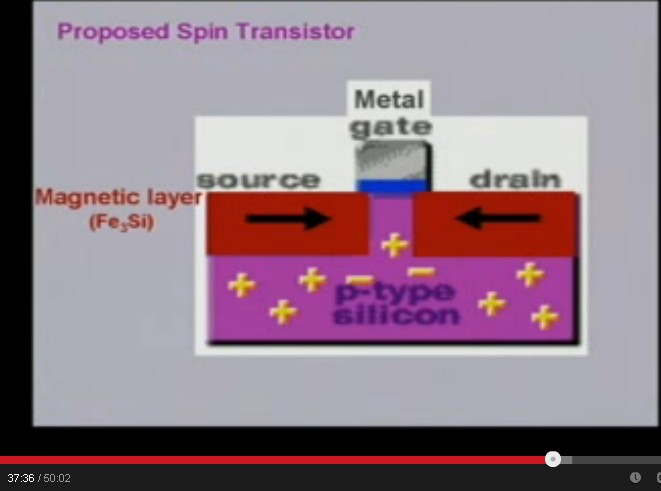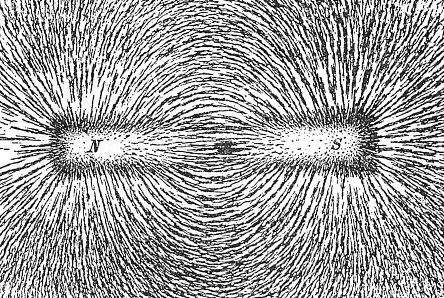It looks like you're using an Ad Blocker.
Please white-list or disable AboveTopSecret.com in your ad-blocking tool.
Thank you.
Some features of ATS will be disabled while you continue to use an ad-blocker.
share:
Ive often wondered if lines of flux could be proven to have a "current", whether it would be possible to switch the whole thing on or off with a
small applied input, much like a transistor. Perhaps the internal material makeup of the magnet could be made with "dipoles" that could be brought
to a state of "semi-magnetizing" and would flip with the slightest provocation.
Any solid state engineer to come up with this please give me honorary mention.
Any solid state engineer to come up with this please give me honorary mention.
originally posted by: magnecore
Ive often wondered if lines of flux could be proven to have a "current", whether it would be possible to switch the whole thing on or off with a small applied input, much like a transistor. Perhaps the internal material makeup of the magnet could be made with "dipoles" that could be brought to a state of "semi-magnetizing" and would flip with the slightest provocation.
Any solid state engineer to come up with this please give me honorary mention.
Transistors that switch on when a magnet is near have been around for a long time. Just take a look at a modern automobile ignition system, or have I not understood your post?
Look up Hall effect transistor.
edit on 9-9-2014 by VoidHawk because: (no reason given)
a reply to: VoidHawk
Yes Im familiar with a hall effect device......I am suggesting a self-oscillating magnet. Maybe not even switching polarities, but at least altering its flux enough to cut across some copper wires to generate a potential. Placing the magnet in an altered state perhaps slightly magnetic, then feed a portion of that "current" back into the core of the magnet to set up oscillations. Yeah I know, perpetual motion doesnt exist.
Yes Im familiar with a hall effect device......I am suggesting a self-oscillating magnet. Maybe not even switching polarities, but at least altering its flux enough to cut across some copper wires to generate a potential. Placing the magnet in an altered state perhaps slightly magnetic, then feed a portion of that "current" back into the core of the magnet to set up oscillations. Yeah I know, perpetual motion doesnt exist.
edit on 9-9-2014 by magnecore because: content
originally posted by: magnecore
Yeah I know, perpetual motion doesnt exist.
Actually I'm more inclined to think we just haven't worked out how to achieve it..yet!
originally posted by: magnecore
Yes Im familiar with a hall effect device......I am suggesting a self-oscillating magnet. Maybe not even switching polarities, but at least altering its flux enough to cut across some copper wires to generate a potential. Placing the magnet in an altered state perhaps slightly magnetic, then feed a portion of that "current" back into the core of the magnet to set up oscillations.
Thats really interesting
Have you looked at John Bedini's SSG? Simple School Girl. It uses magnets and transistors.
originally posted by: VoidHawk
originally posted by: magnecore
Yeah I know, perpetual motion doesnt exist.
Actually I'm more inclined to think we just haven't worked out how to achieve it..yet!
published 14 January 2004
Here we show that a wide range of states of phases and amplitudes exist for a circularly polarized ~CP! plane
wave to act on a classical hydrogen model to achieve infinite times of stability ~i.e., no orbital decay due to
radiation reaction effects!.
Calphysics Source
Will an infinite qualify for a taboo perpetual?
Magnets do get weaker over a large amount of time, but so does rubber and a whole lot of other things too. Magnets can last over 30 years, which is
better than any consumer battery out there.
That said, what Magnecore means is, switching a large magnetic flux with a small amount of wattage (volts/amps). Like a hall sensor in reverse. We can do it with polorized light (pockels cell), why not a magnetic field.
That said, what Magnecore means is, switching a large magnetic flux with a small amount of wattage (volts/amps). Like a hall sensor in reverse. We can do it with polorized light (pockels cell), why not a magnetic field.
If I understand what you're describing, a device that has the following characteristics:
originally posted by: magnecore
Ive often wondered if lines of flux could be proven to have a "current", whether it would be possible to switch the whole thing on or off with a small applied input, much like a transistor. Perhaps the internal material makeup of the magnet could be made with "dipoles" that could be brought to a state of "semi-magnetizing" and would flip with the slightest provocation.
Any solid state engineer to come up with this please give me honorary mention.
1. switch the whole thing on or off with a small applied input, much like a transistor
2. Uses magnetism
That's the subject of this video, a transistor-like device that operates on magnetism conceived by a physicist:
Atoms to X-Rays: Spin Electronics
Here's a screenshot from 37:36 of the proposed device:

You may not have been thinking of electron spin, but it is a form of magnetism.
I believe the OP is just talking about a permanent magnet you can turn on or off with a small input signal.
I don't see why we can't. A magnet is a magnet because the dipoles are aligned. Just scramble the direction of the dipoles and it will demagnetize the magnet, effectively turning the magnet "off". Align the dipoles again, and it becomes a magnet again, or "on".
To do such a thing you would need other magnets, or electromagnets. You would have to create a permanent magnet with multiple tiny electromagnets built into the body, and when you want to demagnetize you turn on all the electromagnets with alternating current ( so the polarity of the tiny electromagnets flips around randomly), this will scramble the dipoles, and disorient them, and demagnetize the main magnet. When you want the magnet to come back, you just turn all the electromagnets on with direct current, so all the electromagnets polarities are aligned (and not flipping). This should magnetize the magnet again.
....or you can just use an electromagnet.
I don't see why we can't. A magnet is a magnet because the dipoles are aligned. Just scramble the direction of the dipoles and it will demagnetize the magnet, effectively turning the magnet "off". Align the dipoles again, and it becomes a magnet again, or "on".
To do such a thing you would need other magnets, or electromagnets. You would have to create a permanent magnet with multiple tiny electromagnets built into the body, and when you want to demagnetize you turn on all the electromagnets with alternating current ( so the polarity of the tiny electromagnets flips around randomly), this will scramble the dipoles, and disorient them, and demagnetize the main magnet. When you want the magnet to come back, you just turn all the electromagnets on with direct current, so all the electromagnets polarities are aligned (and not flipping). This should magnetize the magnet again.
....or you can just use an electromagnet.
If you have nothing other than a small input signal, that small signal won't be enough to re-align many of the dipoles of a permanent magnet in a different direction. If you do any of the things you suggested, it will not be anything like a transistor, at all. That spin transistor is the closest thing I've seen to a transistor-like device to control magnetism.
originally posted by: WeAre0ne
I believe the OP is just talking about a permanent magnet you can turn on or off with a small input signal.
I don't see why we can't.
They work well, and I'm not sure what magnecore is trying to accomplish specifically with using a permanent magnet rather than an electromagnet. Electromagnets are made for turning on and off, permanent magnets aren't, so in that respect trying to turn a permanent magnet on and off seems like using the wrong tool for the job, sort of like trying to hammer with a screwdriver....a screwdriver just doesn't make a very good hammer because it's not the right tool for the job. Likewise a permanent magnet doesn't make a very good on and off magnet because it's not the right tool for the job. You can change the polarity, but even if you have a small input signal, that would need to control a circuit that used a large current through a coil to re-align the permanent magnet dipoles, which isn't much like a transistor at that point.
....or you can just use an electromagnet.
originally posted by: Arbitrageur
If you have nothing other than a small input signal, that small signal won't be enough to re-align many of the dipoles of a permanent magnet in a different direction.
That all depends on the scale we are talking about. On a really small scale, it is possible.
originally posted by: Arbitrageur
If you do any of the things you suggested, it will not be anything like a transistor, at all. That spin transistor is the closest thing I've seen to a transistor-like device to control magnetism.
I don't think the OP wants it to be a transistor. He just wants the permanent magnet to be switchable with a small input signal, like a transistor is switchable.
originally posted by: OccamsRazor04
originally posted by: magnecoreYeah I know, perpetual motion doesnt exist.
Magnets are more like a battery anyways, so it's not perpetual, they run out.
The alternator of my 1962 Honda motorcycle has 6 permanent magnets, and even though it's more than 50 years old, it stills works 100%
Fifty years later and its still working like new! if there is any loss from the magnets the loss must be very very small, especially when compared with the vast amount of electricity created over all those years!
So, permanent magnet alternators do create electricity for well over 50 years without any noticeable loss of magnetism.
Many motorcycle manufacturers still make their alternators using permanent magnets that dont 'run out
Permanent magnets would last forever, and never get weak, if they were isolated from any and all external magnetic fields because the dipoles would
stay aligned.
Permanent magnets slowly get weaker because of external magnetic fields (both strong and weak) which cause the dipoles of the permanent magnets to disorient over time, which causes the overall magnetic field to decrease. This includes the magnetic force from Earth.
Permanent magnets get weaker faster if they are constantly being repelled by another magnet. However, if they are being attracted by another magnet, the permanent magnets strength can be retained.
It only takes a second to recharge a magnet back to its original state by magnetizing it with another more powerful magnet.
In some cases, if the magnetic flux lines of a magnet are contained in a loop, they will never get weaker ever.
If a permanent magnet is in an environment where there is a constant source of magnetic force, those magnets will retain their magnetism forever. An alternator is a good example. The permanent magnets in the alternator induce a magnetic field in the coils when they pass by, and that magnetic field from the coils actually recharges the permanent magnets. When I say recharge, I mean it aligns the dipoles.
Permanent magnets don't always get weaker. That is a myth.
Permanent magnets slowly get weaker because of external magnetic fields (both strong and weak) which cause the dipoles of the permanent magnets to disorient over time, which causes the overall magnetic field to decrease. This includes the magnetic force from Earth.
Permanent magnets get weaker faster if they are constantly being repelled by another magnet. However, if they are being attracted by another magnet, the permanent magnets strength can be retained.
It only takes a second to recharge a magnet back to its original state by magnetizing it with another more powerful magnet.
In some cases, if the magnetic flux lines of a magnet are contained in a loop, they will never get weaker ever.
If a permanent magnet is in an environment where there is a constant source of magnetic force, those magnets will retain their magnetism forever. An alternator is a good example. The permanent magnets in the alternator induce a magnetic field in the coils when they pass by, and that magnetic field from the coils actually recharges the permanent magnets. When I say recharge, I mean it aligns the dipoles.
Permanent magnets don't always get weaker. That is a myth.
edit on 10-9-2014 by WeAre0ne because: (no reason given)
a reply to: WeAre0ne
It's a long time since I bought a magnet of any sort but the old AlNiCo type permanent magnets used to be supplied with an 'armature' which is a ferromagnetic bar that 'short circuited' the magnet's poles IE maintained maximum flux density through the entire magnet which gave the magnet maximum life expectancy as well as reducing external effects in storage or transport.
The same principle should be applied in the magnet's use by having the absolute minimum airgaps in the magnetic circuit which, to me at least, is the biggest give-away when looking at the multitude of claimed miracle over unity devices involving magnets - they have no magnetic circuit at all and generally consist of various configurations of magnets surrounded by free space.
Alternators, at least the non-toy types, do not have permanent magnets because there would be no way to control the excitation for regulation of the output voltage. Most large alternators have a 'pilot' excitation system which relies on the residual magnetic field in the rotor core from the previous use to get them started in absence of any external DC supply.
But back to the thread OP, if a means of modulating a permanent magnetic field is discovered with less energy input than the potential energy output from that moving magnetic field then it will be Nobel prize material The no moving parts over unity alternator :O
It's a long time since I bought a magnet of any sort but the old AlNiCo type permanent magnets used to be supplied with an 'armature' which is a ferromagnetic bar that 'short circuited' the magnet's poles IE maintained maximum flux density through the entire magnet which gave the magnet maximum life expectancy as well as reducing external effects in storage or transport.
The same principle should be applied in the magnet's use by having the absolute minimum airgaps in the magnetic circuit which, to me at least, is the biggest give-away when looking at the multitude of claimed miracle over unity devices involving magnets - they have no magnetic circuit at all and generally consist of various configurations of magnets surrounded by free space.
Alternators, at least the non-toy types, do not have permanent magnets because there would be no way to control the excitation for regulation of the output voltage. Most large alternators have a 'pilot' excitation system which relies on the residual magnetic field in the rotor core from the previous use to get them started in absence of any external DC supply.
But back to the thread OP, if a means of modulating a permanent magnetic field is discovered with less energy input than the potential energy output from that moving magnetic field then it will be Nobel prize material The no moving parts over unity alternator :O
Interesting idea.
I wonder if the field adds up for a series of magnets alinged in attraction to each other? If so, maybe you could keep them phyically separated with airgaps, and put-in or pull out plates of diamagnetic material in-between them. If it could do what I'd think it'd do, you'd have all the fields lined up and adding when the diamagnetic gates are pulled out and scattering a bit randomly and the sum field lines weaker when the gates are inserted.
Not sure if such a thing would yield enough of a resulting difference to be interesting though.
I wonder if the field adds up for a series of magnets alinged in attraction to each other? If so, maybe you could keep them phyically separated with airgaps, and put-in or pull out plates of diamagnetic material in-between them. If it could do what I'd think it'd do, you'd have all the fields lined up and adding when the diamagnetic gates are pulled out and scattering a bit randomly and the sum field lines weaker when the gates are inserted.
Not sure if such a thing would yield enough of a resulting difference to be interesting though.
originally posted by: magnecore
a reply to: VoidHawk
Yes Im familiar with a hall effect device......I am suggesting a self-oscillating magnet. Maybe not even switching polarities, but at least altering its flux enough to cut across some copper wires to generate a potential. Placing the magnet in an altered state perhaps slightly magnetic, then feed a portion of that "current" back into the core of the magnet to set up oscillations. Yeah I know, perpetual motion doesnt exist.
You've described an inductor in a resonant circuit. Been around since the early 1800s.
I've often wondered if flux lines could be manipulated into a structure and bound, to construct a machine or other object out of flux lines.
a reply to: mikefougnie
Flux lines are not real. They are representations of field strength. There are no gaps in a magnetic field. When field lines are drawn farther apart it means the field is weaker in that region.
Flux lines are not real. They are representations of field strength. There are no gaps in a magnetic field. When field lines are drawn farther apart it means the field is weaker in that region.
edit on 9/15/2014 by Phage because: (no reason given)
a reply to: Phage
Although I know magnetic lines are a simple graphical way to represent the direction and strength of a magnetic field. I have to disagree that magnetic lines of force are not real.
A magnetic field is not a perfect solid field. A magnetic field consists of numerous streams of various strengths, which do indeed form lines.
That is why iron fillings produce lines around a magnet.

That is why the solar prominences often follow magnetic lines.

Also why polar auroras follow the Earth's magnetic field lines.

My own experimentation has confirmed the existence of these magnetic streams as well, and their natural desire to form loops.
Although I know magnetic lines are a simple graphical way to represent the direction and strength of a magnetic field. I have to disagree that magnetic lines of force are not real.
A magnetic field is not a perfect solid field. A magnetic field consists of numerous streams of various strengths, which do indeed form lines.
That is why iron fillings produce lines around a magnet.

That is why the solar prominences often follow magnetic lines.

Also why polar auroras follow the Earth's magnetic field lines.

My own experimentation has confirmed the existence of these magnetic streams as well, and their natural desire to form loops.
new topics
-
The art of being offended
Social Issues and Civil Unrest: 1 hours ago -
FLORIDA Sues Biden-Harris FEMA for Denying Disaster Assistance to Homeowners with TRUMP Signs.
US Political Madness: 2 hours ago -
Turns out, they planned to go after P-nut.
US Political Madness: 6 hours ago
top topics
-
Comcast dumping MSNBC
Mainstream News: 15 hours ago, 22 flags -
Turns out, they planned to go after P-nut.
US Political Madness: 6 hours ago, 17 flags -
The art of being offended
Social Issues and Civil Unrest: 1 hours ago, 8 flags -
Sick sick sick ---graphic story
Social Issues and Civil Unrest: 12 hours ago, 7 flags -
FLORIDA Sues Biden-Harris FEMA for Denying Disaster Assistance to Homeowners with TRUMP Signs.
US Political Madness: 2 hours ago, 4 flags
active topics
-
President-Elect DONALD TRUMP's 2nd-Term Administration Takes Shape.
Political Ideology • 174 • : SourGrapes -
Should we look for the truth, or just let it go?
US Political Madness • 116 • : Lazy88 -
Turns out, they planned to go after P-nut.
US Political Madness • 21 • : network dude -
Comcast dumping MSNBC
Mainstream News • 22 • : Flyingclaydisk -
The Acronym Game .. Pt.4
General Chit Chat • 951 • : tinkerbell99 -
The art of being offended
Social Issues and Civil Unrest • 13 • : Oldcarpy2 -
The Trump effect 6 days after 2024 election
2024 Elections • 109 • : cherokeetroy -
Elon's Starlink Stole The Election For Trump--Leftist Conspiracy Theorists Charge
General Conspiracies • 42 • : DoubleDNH -
WATCH LIVE: US Congress hearing on UFOs, unidentified anomalous phenomena
Aliens and UFOs • 46 • : imitator -
FLORIDA Sues Biden-Harris FEMA for Denying Disaster Assistance to Homeowners with TRUMP Signs.
US Political Madness • 18 • : grey580
